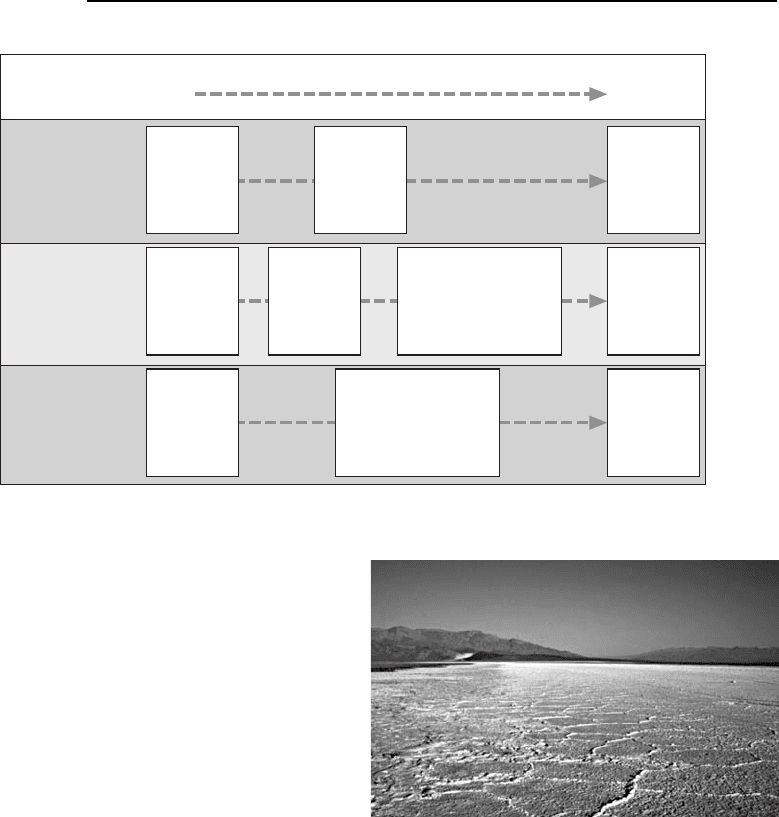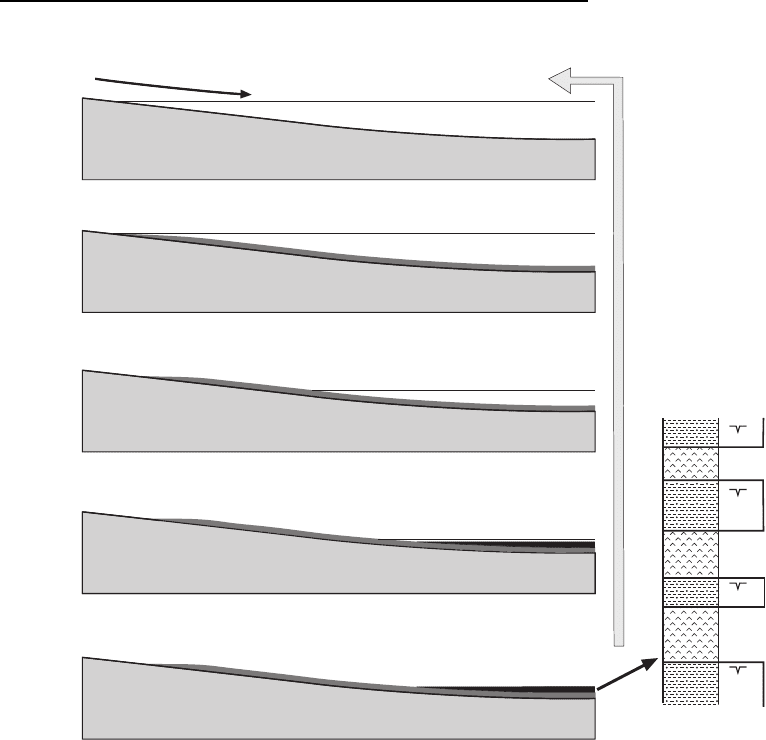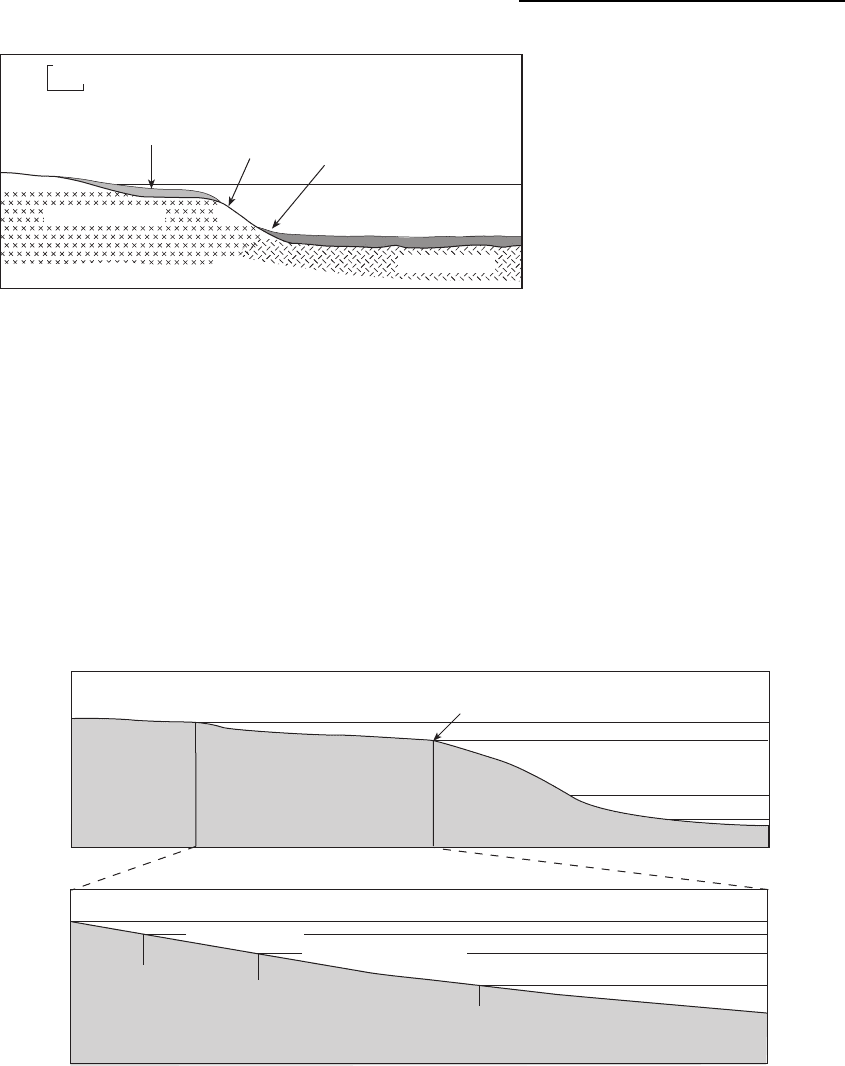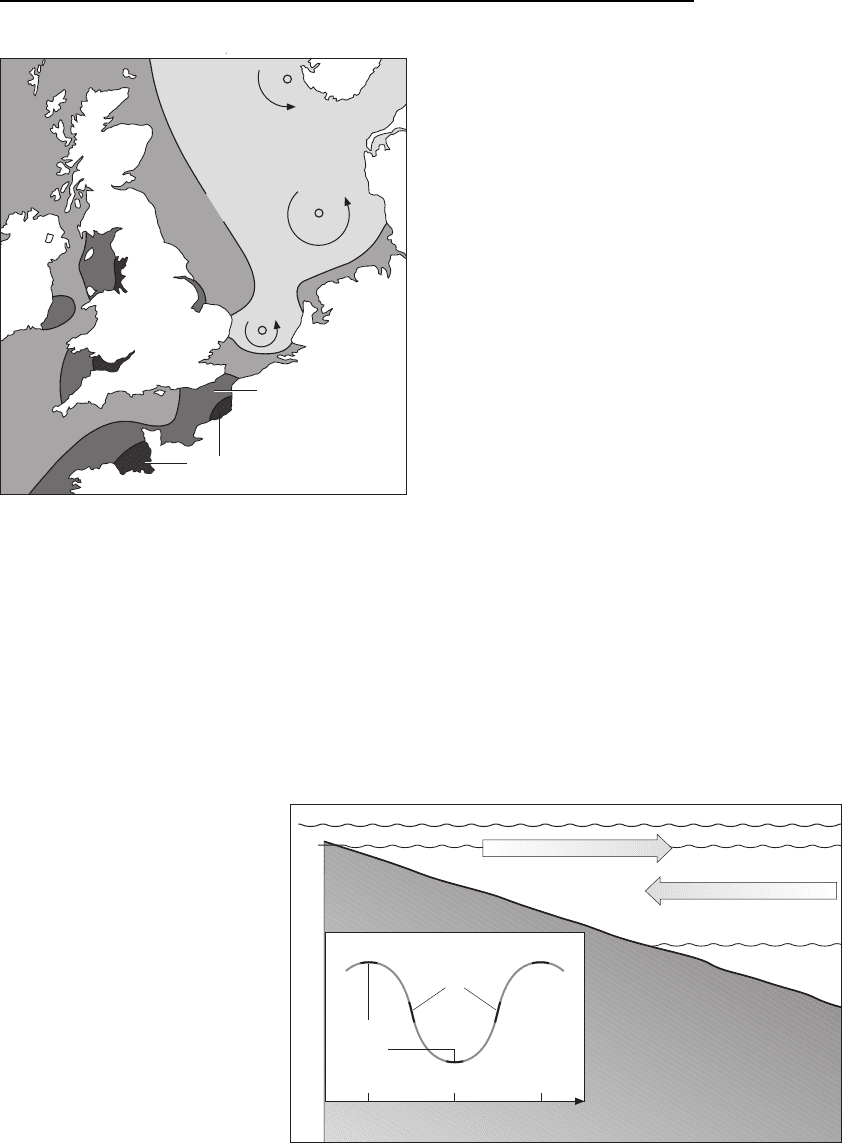Gary Nichols. Sedimentology and Stratigraphy(Second Edition)
Подождите немного. Документ загружается.


organic-rich shales. Seasonal temperature variations
in permanent saline lakes result in a fine layering.
This is due to direct precipitation of calcium carbonate
as aragonite needles in the hot summer to form white
laminae, which alternate with darker laminae formed
by clastic input when sediment influx is greater in the
winter.
10.4 EPHEMERAL LAKES
Large bodies of water that periodically dry out are
probably best described as ephemeral lakes,
although the term playa lake is also commonly
used (Briere 2000). Terms such as ‘saline pan’ are
also sometimes used to describe these temporary lake
environments. It is perhaps simpler to just use the
term ‘ephemeral lakes’ as this unambiguously implies
that the water body is temporary. They occur in semi-
arid and arid environments where the rainfall is low
and the rate of evaporation is high.
Many desert areas are subject to highly irregular
rainfall with long periods of dry conditions inter-
rupted by intense rainfall that may occur only every
few years or tens of years. After rainfall in the catch-
ment area, the rivers become active (9.2.3) and flash
floods supply water and sediment to the basin centre
where it ponds to form a lake. Once the lake has
formed, particles suspended in the water will start to
deposit and form a layer of fine-grained muddy sedi-
ment (Lowenstein & Hardie 1985). Evaporation of the
water body gradually reduces its volume and the area
of the lake starts to shrink, leaving areas of margin
exposed where desiccation cracks (4.6) may form in
the mud as it dries out. With further evaporation the
ion concentration in the water starts to increase to
the point where precipitation of minerals occurs. The
Increasing amount of evaporation
Normal waters
Ca~Mg
HCO
3
~ Ca + Mg
Sulphate and
chloride waters
Ca >> Mg
HCO
3
<< Ca + Mg
Sodium-enriched
carbonate waters
Ca >> Mg
HCO
3
>> Ca + Mg
Calcium
carbonate
CaCO
3
Halite
NaCI
Mg salts
& others
Gypsum
CaSO
4
.2H
2
O
Calcium
carbonate
CaCO
3
Halite
NaCI
& other
salts
Sodium sulphates
e.g. mirabilite
Na
2
SO
4
.10H
2
O
Calcium
carbonate
CaCO
3
Halite
NaCI
& other
salts
Soda salts
e.g. trona
NaHCO
3
.NaCO
3
.2H
2
O
Gypsum
CaSO
4
.2H
2
O
Fig. 10.8 Three general types of saline lake can be distinguished on the basis of their chemistry.
Fig. 10.9 A salt crust of minerals formed by evaporation in
an ephemeral lake.
158 Lakes

least soluble minerals will precipitate first, followed by
other evaporite minerals until the lake has dried
up completely (Fig. 10.9). The resulting deposit con-
sists of a layer of mud overlain by a layer of evaporite
minerals (Fig. 10.10) The minerals formed by eva-
poration will be determined by the chemistry of the
waters and show the same ranges of composition as
is found in saline lakes. Subsequent flooding of the
lake floor following another flood event does not
necessarily result in solution of the evaporite minerals
on the surface as they may become quickly blanketed
by mud.
Repeated flooding and evaporation results in a ser-
ies of depositional couplets of a layer of mud over-
lain by a layer of evaporite minerals: these couplets
are typically a few millimetres to centimetres thick
and are a characteristic signature of ephemeral lake
deposition (Lowenstein & Hardie 1985). Ephemeral
lake deposits occur in arid environments and
are therefore likely to be associated with other facies
formed in these settings: these will include aeolian
sandflat and dune deposits, alluvial fan facies and
material deposited by flash floods from ephemeral riv-
ers. These facies are likely to be found interfingering
with ephemeral lake deposits to form a facies associa-
tion characteristic of arid depositional environments.
Evaporite minerals also form within the sediments
surrounding ephemeral lakes. In these areas the
cycle repeats:
generates
mudstoneevaporite
couplets
Influx of water and suspended sediment
Settling out of suspension as a layer of mud
Lake shrinks, desiccation at margins
Concentration of ions leads to evaporite precipitation
Complete evaporation of lake waters
mudcracks
Fig. 10.10 When an ephemeral lake receives an influx of water and sediment, mud is deposited from suspension to form a thin
bed that is overlain by evaporite minerals as the water evaporates. Repetitions of this process create a series of couplets of
mudstone and evaporite.
Ephemeral Lakes 159

sediment is saturated with saline groundwater, which
evaporates at the ground surface, concentrating the
dissolved minerals and leading to the crystallisation
of evaporite minerals. These regions are sometimes
referred to as inland sabkhas (cf. coastal sabkhas:
15.2.3) and the most common mineral to be formed is
gypsum, which grows within the sediment in an
interconnected mass of bladed crystals known as
desert rose.
10.5 CONTROLS ON LACUSTRINE
DEPOSITION
The characteristics of the deposits of lacustrine envi-
ronments are controlled by factors that control the
depth and size of the basin (which are largely deter-
mined by the tectonic setting), the sediment supply to
the lake (which is a function of a combination of
tectonics and climatic controls on relief and weath-
ering) and the balance between water supply and loss
through evaporation (which is principally related to
the climate). If the climate is humid a lake will be
hydrologically open, with water flowing both in and
out of it. Such lakes can be considered to be overfilled
(Bohacs et al. 2000, 2003), and their deposits are
characterised by accumulation both at the margins,
where sediment is supplied to deltas and beaches, and
in the deep water from suspension and turbidity cur-
rents. The lake level remains constant, so there is no
evidence of fluctuations in water depth under these
conditions.
A balanced fill lake is one where the fluvial input
is approximately balanced by the loss through eva-
poration. These lakes are sensitive to variations in the
climate because a reduction in water input and/or an
increase in evaporation (drier and/or warmer condi-
tions) will result in a fall in the water level below the
sill and the system becomes hydrologically closed.
The area of the lake will contract, shifting the lake
shoreline towards the basin centre and leaving a pe-
ripheral area exposed to subaerial conditions where
desiccation cracks may form, plants colonise the sur-
face and pedogenic processes modify the sediment. A
fall in the water level will also bring parts of the lake
floor that were previously below the wave base into
shallower water where wave ripples rework the sedi-
ment. These changes will be reversed if the climate
reverts to wetter and/or cooler conditions, as the lake
level rises and the lake margin is reflooded. The deposits
of lakes subject to climatic and lake level fluctuations
will exhibit frequent vertical changes in facies.
Saline and ephemeral lakes are underfilled
(Bohacs et al. 2000, 2003). Some saline lakes may
become relatively fresh if there is a change to wetter,
cooler conditions, allowing the formation of a strati-
fied water body and consequently the accumulation of
organic-rich sediment on the lake floor. A return to a
drier climate increases evaporation and concentration
of ions leading to evaporite deposition. Cycles of cli-
mate change can be recognised in some lake deposits
as alternations between dark, carbonaceous mudrock
(sometimes oil shales: 3.6.3) and beds of gypsum and
other evaporite minerals. The areas of shallow saline
and ephemeral lakes can show considerable varia-
tions through time as a result of changes in climate.
The rate of sediment supply is significant in all
lacustrine environments. If the rate of deposition of
clastic, carbonate and evaporite deposits is greater
than the rate of basin subsidence (Chapter 24) the
lake basin will gradually fill. In overfilled lake settings
this will result in a change from lacustrine to fluvial
deposition as the river waters no longer pond in
the lake but instead flow straight through the former
lake area with channel and overbank deposits accu-
mulating. Balanced fill and underfilled basins will also
gradually fill with sediment, sometimes to the level of
the sill such that they also become areas of fluvial
deposition.
10.6 LIFE IN LAKES AND FOSSILS
IN LACUSTRINE DEPOSITS
Palaeontological evidence is often a critical factor in
the recognition of ancient lacustrine facies. Fresh-
water lakes may be rich in life with a large number
of organisms, but they are of a limited number of
species and genera when compared with an assem-
blage from a shallow marine environment. Fauna
commonly found in lake deposits include gastropods,
bivalves, ostracods and arthropods, sometimes occur-
ring in monospecific assemblages, that is, all organ-
isms belong to the same species. Some organisms,
such as the brine shrimp arthropods, are tolerant of
saline conditions and may flourish in perennial saline
lake environments.
Algae and cyanobacteria are an important compo-
nent of the ecology of lakes and also have sedimento-
logical significance. A common organism found in
160 Lakes

lake deposits are charophytes, algae belonging to the
Chlorophyta (3.1.3), which are seen in many ancient
lacustrine sediments in the form of calcareous
encrusted stems and spherical reproductive bodies.
Charophytes are considered to be intolerant of high
salinities and the recognition of these millimetre-
scale, often dark, spherical bodies in fine-grained
sediment is a good indicator of fresh or possibly brack-
ish water conditions.
Cold, sediment-starved lakes in mountainous or polar
environments may be sites of deposition of siliceous
oozes (3.3). The origin of the silica is diatom phyto-
plankton, which can be very abundant in glacial
lakes. These deposits are typically bright white cherty
beds that are called diatomites , and they are basi-
cally made up entirely of the silica from diatoms.
10.7 RECOGNITION OF LACUSTRINE
FACIES
If the succession is entirely terrigenous clastic mate-
rial, it is not always easy to distinguish between the
deposits of a lake and those of a low energy marine
environment such as a lagoon (13.3.2 ), the outer part
of a shelf (Chapter 14) or even the deep sea (Chapter
16). Shallow lake facies will have similar character-
istics to lagoonal deposits, with wave ripple sands
interbedded with muds deposited from suspension,
while the deeper environments of a lake resemble
those of seas with similar or greater depths, as they
include deposits from suspension and turbidites. The
main criteria for distinguishing between lacustrine
and marine facies are often the differences between
the organisms and habitats that exist in these envi-
ronments.
There are a number of groups of organisms that are
found only in fully marine environments: these
include corals, echinoids, brachiopods, cephalopods,
graptolites and foraminifers, amongst others (3.1.3).
The occurrence of fossils of members of these groups
therefore provides evidence of marine deposition.
There are many genera of other phyla that can be
used as indicators if found as fossils, in particular
there are groups of bivalve and gastropod molluscs
that are considered to be freshwater forms, and fish
that are thought to be exclusively lake-dwellers.
Some of the more reliable indicators of freshwater
conditions are algal and bacterial (3.1.3) fossil
forms. Reliance on fossils to provide indicators of
lacustrine environments becomes more difficult in
rocks that are from further back in the stratigraphic
record, and in Precambrian strata it may be almost
impossible to be sure.
A feature of lakes that is much less commonly
found in marine settings is the stratification of the
water body (Fig. 10.3). The lack of mixing of the
oxygenated surface water with the lower part of
the water column results in anaerobic conditions at
the bottom of a deep, stratified lake. Animals are
unable to tolerate the anaerobic conditions so the
lake floor is devoid of life, and therefore there is no
bioturbation (11.7). Deep lake deposits may therefore
preserve primary sedimentary lamination that in
marine environments is typically destroyed by bur-
rowing organisms. The anoxia also prevents the aero-
bic breakdown of organic material that settles on the
lake floor, allowing the accumulation of organic-rich
sediments. The deposits of saline and ephemeral lakes
usually can be distinguished from marine facies by the
chemistry of the evaporite minerals.
Characteristics of lake deposits
. lithologies – sandstone, mudstone, fine-grained
limestones and evaporites
. mineralogy – variable
. texture – sands moderately well sorted
. bed geometry – often very thin-bedded
. sedimentary structures – wave ripples and very fine
parallel lamination
. palaeocurrents – few with palaeoenvironmental sig-
nificance
. fossils – algal and microbial plus uncommon shells
. colour – variable, but may be dark grey in deep lake
deposits
. facies associations – commonly occur with
fluvial deposits, evaporites and associated with aeo-
lian facies
FURTHER READING
Anado
´
n, P., Cabrera, L. & Kelts, K. (Eds) (1991) Lacustrine
Facies Analysis. Special Publication 13, International
Association of Sedimentologists. Blackwell Science,
Oxford, 318 pp.
Bohacs, K.M., Carroll, A.R., Neal, J.E. & Mankiewicz, P.J.
(2000) Lake-basin type, source potential, and hydro-
carbon character: an integrated-sequence-stratigraphic–
geochemical framework. In: Lake Basins through Space
and Time (Eds Gierlowski-Kordesch, E.H. & Kelts, K.R.).
Further Reading 161

Studies in Geology 46, American Association of Petroleum
Geologists, Tulsa, OK; 3–34.
Bohacs, K.M., Carroll, A.R. & Neal, J.E. (2003) Lessons from
large lake systems – thresholds, nonlinearity, and strange
attractors. In: Extreme Depositional Environments: Mega End
Members in Geologic Time (Eds Chan, M.A. & Archer, A.
W.). Geological Society of America Special Paper 370,
Boulder, CO; 75–90.
Carroll, A.R. & Bohacs, K.M. (1999) Stratigraphic classifica-
tion of ancient lakes: balancing tectonic and climatic con-
trols: Geology, 27, 99–102.
Matter, A. & Tucker, M.E. (Eds) (1978) Modern and Ancient
Lake Sediments, Special Publication 2, International Asso-
ciation of Sedimentologists. Blackwell Scientific Publica-
tions, Oxford, 290 pp.
Talbot, M.R. & Allen, P.A. (1996) Lakes. In: Sedimentary
Environments: Processes, Facies and Stratigraphy (Ed. Read-
ing, H.G.). Blackwell Scientific Publications, Oxford;
83–124.
Tucker, M.E. & Wright, V.P. (1990) Lacustrine carbonates.
In: Carbonate Sedimentology. Blackwell Scientific Publica-
tions, Oxford; 164–190.
162 Lakes

11
The Marine Realm:
Morphology and Processes
The oceans and seas of the world cover almost three-quarters of the surface of the planet
and are very important areas of sediment accumulation. The oceans are underlain by
oceanic crust, but at their margins are areas of continental crust that may be flooded by
seawater: these are the continental shelves. The extent of marine flooding of these
continental margins has varied through time due to plate movements and the rise and
fall in global sea level related to climate changes. The sedimentary successions in these
shallow shelf areas provide us with a record of global and local tectonic and climatic
variations. There is considerable variety in the sedimentation that occurs in the marine
realm, but there are a number of physical, chemical and biological processes that are
common to many of the marine environments. Physical processes include the formation
of currents driven by winds, water density, temperate and salinity variations and tidal
forces: these have a strong effect on the transport and deposition of sediment in the
seas. Chemical reactions in seawater lead to the formation of new minerals and the
modification of detrital sediment. The seas also team with life: long before there was life
on land organisms evolved in the marine realm and continue to occupy many habitats
within the waters and on the sea floor. The remains of these organisms and the evidence
for their existence provide important clues in the understanding of palaeoenvironments.
11.1 DIVISIONS OF THE MARINE
REALM
The bathymetry, the shape and depth of the sea
floor (Fig. 11.1), is fundamentally determined by the
plate tectonic processes that create ocean basins by
sea-floor spreading. The spreading ridges are areas
of young, hot basaltic crust that is relatively buoyant
and typically around 2500 m below sea level. Away
from the ridges the water depth increases as the older
crust cools and subsides, and most of the ocean floor
is between about 4000 and 5000 m below sea level.
The deepest parts of the oceans are the ocean
trenches created by subduction zones, where water
depths can be more than 10,000 m. At the ocean
margins the transition from ocean crust to continental
crust underlies the continental rise and the
continental slope, which are the lower and upper

parts of the bathymetric profile from the deep ocean
to the shelf. The angle of the continental slope is
relatively steep, usually between about 2
˚
and 7
˚
,
while the continental rise is a lower angle slope
down to the edge of the abyssal plain.
The continental shelf itself is underlain by conti-
nental crust, and the junction between the shelf and
the slope usually occurs at about 200 m below sea
level at present-day margins (the shelf edge break).
Continental shelves are very gently sloping with gra-
dients ranging from steep shelves of 1 in 40 to more
typical gradients of 1 in 1000. They may extend for
tens to hundreds of kilometres from the coastline to
the shelf edge break. Large areas of continental crust
that are covered by seawater, which are mainly bor-
dered by land masses and connected by straits to the
oceans, are called epicontinental seas (sometimes
called epeiric seas). The areas of epicontinental seas
are greatest when relative sea levels are at the highest
worldwide. A nomenclature for the division of the
marine realm based on these depth zones is shown
in Fig. 11.2. The shelf area, down to 200 m water
depth, is called the neritic zone, the bathyal zone
corresponds to the continental slope and extends from
200 m to 2000 m water depth, while the abyssal
zone is the ocean floor below 2000 m. A depth limit
land
continental
shelf
continental
slope
continental
rise
abyssal plain
100 km
2km
Continental crust
Oceanic crust
Fig. 11.1 A cross-section from the
continental shelf through the continental
slope and rise down to the abyssal plain.
sea level
bathyal zone
200 m
abyssal zone
~4000 m
sea level
mean high water
mean low water
fair weather wave base
storm wave base
offshore-transition
shoreface
foreshore
offshore
neritic zone
~5000 m
hadal zone
shelf edge break
Fig. 11.2 Depth-related divisions of the marine realm: (a) broad divisions are defined by water depth; (b) the shelf is described
in terms of the depth to which different processes interact with the sea floor, and the actual depths vary according to the
characteristics of the shelf.
164 The Marine Realm: Morphology and Processes

to this zone can also be applied at about 5000 m,
below which the deepest parts of the oceans are called
the hadal zone.
The shelf (neritic environment) can be usefully
further divided into depth-controlled zones (Fig. 11.2),
although in this case the divisions are not defined
by absolute depths, but the depths to which certain
processes operate. Their range therefore varies
according to the conditions in a particular basin
because the depths to which tidal processes, waves
and storms affect the shelf vary considerably. The
foreshore is the region between mean high water
and mean low water marks of the tides. Depending
on the tidal range (11.2.2) this may be a vertical
distance of anything from a few tens of centimetres
to many metres. The seaward extent of the foreshore
is governed also by the slope and it may be anything
from a few metres, if the shelf is steeply sloping and/or
the tidal range is small, to over a kilometre in places
where there is a high tidal range and a gently sloping
shelf. The foreshore is part of the beach environment
or littoral zone (13.2).
The shoreface is defined as the region of the shelf
between the low-tide mark and the depth to which
waves normally affect the sea bottom (4.4.1), and this
is the fair weather wave base. The lower depth that
the shoreface reaches depends on the energy of the
waves in the area but is typically somewhere between
5 and 20 m. The width of the shoreface will be gov-
erned by the shelf slope as well as the depth of the fair
weather wave base and may be hundreds of metres to
kilometres across. In deeper water it is only the larger,
higher energy waves generated by storms that affect
the sea bed. The depth to which this occurs is the
storm wave base and this is very variable on different
shelves. In some places it may be as little as 20 m
water depth but can be 50 to 200 m water depth
if the shelf borders an ocean with a large fetch for
storm waves. This deeper shelf area between the fair
weather and storm wave bases is called the offshore-
transition zone. The offshore zone is the region
below storm wave base and extends out to the shelf-
edge break at around 200 m depth.
The activities of a number of physical, chemical and
biological processes are determined by water depth,
and in turn these influence the sediment accumula-
tion on the different parts of the sea floor. The following
sections consider some of these processes and how they
affect depositional environments.
11.2 TIDES
11.2.1 Tidal cycles
According to Newton’s Law of Gravitation, all objects
exert gravitational forces on each other, the strength
of which is related to their masses and their distances
apart. The Moon exerts a gravitational force on the
Earth and although ocean water is strongly attracted
gravitationally to the Earth, it also experiences a small
gravitational attraction from the Moon. The water
that is closest to the Moon experiences the largest
gravitational attraction and this creates a bulge of
water, a tidal bulge, on that side of the Earth
(Fig. 11.3). The bulge on the opposite side, facing
away from the Moon, can be thought of as being the
result of the Earth being pulled away from that water
mass by the gravitational force of the Moon.
Fig. 11.3 The gravitational force of the
Sun and Moon act on the Earth and on
anything on the surface, including the
water masses in oceans.
Moon
Sun
Gravitational
force
gravitational
force
Earth rotates under
each tidal bulge once
each day results
in two tides each day
Moon completes orbit
of Earth in 1 month.
When aligned with
Sun (twice a month),
spring tides occur.
When perpendicular,
neap tides occur
tidal bulge
in oceans
centre of mass
of EarthMoon
system
Earths orbit of
Sun is elliptical.
When the Earth
is closest (spring
and autumn
equinoxes), tides
are highest
Earth
Tides 165

If the land areas are ignored the effect of these
bulges is to create an ellipsoid of water with its long
axis oriented towards the position of the Moon. As the
Earth rotates about its axis the bulges move around
the planet. At any point on the surface the level of the
water will rise and fall twice a day as the two bulges
are passed in each rotation. This creates the daily
or diurnal tides . During the daily rotation, a point
on the Earth will pass under one high bulge and
a slightly lower bulge 12 hours or so later: this is
referred to as the diurnal tidal inequality, the two
high tides in a day are not of equal height. The two
tides in the diurnal tidal cycle are just over twelve and
a half hours because the Moon is orbiting the Earth as
the planet is rotating, changing its relative position
each day.
The Moon rotates around the Earth in the same
plane as the Earth’s orbit around the Sun. The Sun
also creates a tide, but its strength is about half that
of the Moon despite its greater mass, because the
Sun is further away. When the Sun and Moon are
in line with the Earth (an alignment known as
syzygy) the gravitational effects of these two bodies
are added together to increase the height of the tidal
bulge. When the Moon is at 90
˚
to the line joining the
Sun and the Earth (the quadratic alignment), the
gravitational effects of the two on the water tend
to cancel each other. During the four weeks of the
Moon’s orbit, it is twice in line and twice perpendicu-
lar. This creates neap–spring tidal cycles with the
highest tides in each month, the spring tides, occur-
ring when the three bodies are in line. (The term
‘spring’ in this context is not referring to the season
of the year.) A week either side of the spring tides
are the neap tides, which occur when the Moon and
Sun tend to cancel each other and the tidal effect is
smallest.
Superimposed on the diurnal and neap–spring cycles
is an annual tidal cycle caused by the elliptical
nature of the Earth’s orbit around the Sun. At the
spring and autumn (Fall) equinoxes, the Earth is clo-
sest to the Sun and the gravitational effect is stron-
gest. The highest tides of the year occur when there
are spring tides in late March and late September. In
mid-summer and mid-winter the Sun is at its furthest
away and the tides are smaller. This pattern of three
superimposed tidal cycles (diurnal, neap–spring and
annual) is a fundamental feature of tidal processes
that controls variations through time of the strength
of tidal currents.
11.2.2 Tidal ranges
The tidal bulge created in the open ocean is only a few
tens of centimetres, but of course the difference
between high and low tide is many metres in some
places, so there must be a mechanism to amplify the
vertical change in sea level. The tidal bulge can be
considered as a wave of water that passes over the
surface of the Earth. In any waveform resonance
effects are created by the shape of the boundaries of
the ‘vessel’ the wave is moving through. In oceans
and seas the shape of the continental shelf as it shal-
lows towards land, indentations of the coastline and
narrow straits between seas can all create resonance
effects in the tidal wave. These can increase the ampli-
tude of the tide and locally the tidal range is increased
to several metres by tidal resonance effects. The high-
est tidal ranges in the world today are in bays on
continental shelves, such as the Bay of Fundy, on
the Atlantic seaboard of Canada, which has a tidal
range of over 15 m (Dalrymple 1984).
In addition to the influence of land masses, the
movement of water between high- and low-tide con-
ditions is also affected by the Coriolis force (6.3):
water masses moving in the northern hemisphere
are deflected to the right of their path and in the
southern hemisphere to the left. These effects break
up the tidal wave into a series of amphidromic cells
and at the centre of each cell there is an amphidro-
mic point around which the tidal wave rotates
(Fig. 11.4). At the amphidromic point there is no
change in the water level during the tidal cycle. All
oceans are divided into a number of major amphidro-
mic cells and there are additional, smaller cells in shelf
areas such as the North Sea and small seas such as
the Gulf of Mexico. Tidal ranges are therefore very
variable and within a body of water the pattern of
tides can be very complex: in the North Sea, for
example, the tidal range varies from less than a
metre to over 6 m (Fig. 11.4). For sedimentological
purposes it is useful to divide tidal ranges into the
following categories: up to 2 m mean tidal range the
regime is microtidal, between 2 and 4 m range it is
mesotidal and over 4 m is macrotidal.
11.2.3 Characteristics of tidal currents
The horizontal movement of water induced by tides is
a tidal current: tidal currents are weak in microtidal
166 The Marine Realm: Morphology and Processes

regimes, more pronounced if the range is mesotidal
and are capable of carrying large quantities of sediment
in macrotidal regimes. Nearshore tidal currents show
a number of features that produce recognisable char-
acteristics in sediment deposited by them (Fig. 11.5).
First, tidal currents regularly change direction from
the flood tide current, which moves water onshore
between the low and high tide, and the ebb tide
current, which flows in the opposite direction as the
water level returns to low tide. These are bipolar
currents acting in two opposite directions. Second,
the tidal flow varies in velocity in a cyclical manner.
At times of high and low tide, the water is still, but as
the tide turns, the water starts to move and increases
in velocity up to a peak at the mid-tide point in each
direction. Third, the strength of the flow is directly
related to the difference between the levels of the high
and low tides. As the tidal range varies according to
the series of cycles (see above) the velocity of the
current varies in the same pattern. The strongest
tidal currents occur when there are the highest spring
tides at the spring and autumn equinoxes.
The rotational pattern of the tidal wave within
amphidromic cells results in a flow of water that
follows a circular or elliptical pattern. These rotary
tides can be important currents on shelves and in
epicontinental seas. During the course of the tidal
cycle the current varies in strength, but does not
change direction and there may not be a period of
slack water (Dalrymple 1992). These offshore tidal
currents are important processes in the transport
and deposition of sediment on some shelf areas (14.3).
11.2.4 Sedimentary structures generated
by tidal currents
Bipolar cross-stratification
An analysis of current directions recorded by cross-
bedding in sands deposited by tidal currents may
mesotidal
(24 m
range)
microtidal
(< 2 m range)
macrotidal
(> 4 m range)
> 6 m range
rotation of the
tidal wave about
amphidromic points
Fig. 11.4 The North Sea of northwest Europe has a variable
tidal range along different parts of the bordering coasts.
Amphidromic points mark the centres of cells of rotary tides
that affect the shallow sea.
Fig. 11.5 During the diurnal tidal
cycle the direction of flow reverses
from ebb (offshore) to flood (onshore).
The current velocity also varies from
peaks at the mid points of ebb and
flood flow, reducing to zero at high
and low tide slack water before
accelerating again.
Twice daily tidal cycle
Water level
Low tide
High tide High tide
offshore
flow
onshore
flow
maximum
flow
velocity
slack
water
high tide level
low tide level
flow offshore as tide falls
ebb tide current
flow onshore as tide rises
flood tide current
Time
Tides 167
